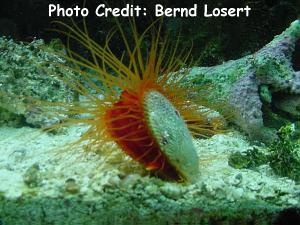
By Bob Goemans

Likely Reef Tank Suitable
Likely Fish-Only Tank Suitable
Range: Western Atlantic Ocean: Caribbean to Central America.
Natural Environment: Inhabits shallow reef environments, and found embedded among stones/rocks and coral rubble.
General Husbandry: This is an attractive species, however, not long lived in aquaria. It persists to be available in many aquarium shops because its mantel is deep red and adorned with long and slender reddish tentacles. It has the ability to swim by opening and closing its shells and expelling water from its internal cavity similar to how a jet engine expels air. They also have a row of tiny eyespots around the edge of the mantle similar to Tridacna clams, which helps them escape predators when seen by jetting away. When seen in shops, they are usually in small aquaria, sometimes in what are called 'racetracks,' which are a row of small cube-shaped acrylic containers, making them readily viewable and accessible for sale.
Once placed in the home aquarium they prefer to find dimly lit protected places, usually back corners of the aquarium or between piles of rock or corals, mostly hiding from view. And if you place it in open well-lighted areas to show-off its nice colors, it will flit here-and-there, sometimes knocking things over while seeking a dimly lit and safer area in the aquarium.
As for its nutritional needs, it's a filter feeder, therefore needs to be fed a supply of preserved and/or live phytoplankton 'at least' once daily.
Since its nutrition is not met while being transported or usually while in dealer tanks, its initial feeding in your aquarium is extremely important. My suggestion is placing it between two small rocks in an area easily assessable and dimly lit. If it feels safe there, it will attach itself and can be hand fed using small flows of food from a turkey baster. In fact, my photo shows its byssal thread/foot coming from the rear portion of its opening, and once finding a suitable place to call home, will securely fasten this appendage to the substrate its sitting on. Plankton-like products that can produce nutritious suspension matter may help extend their stay in aquariums.
Flame scallops are pretty; yet do not usually last much longer than six months in captivity. Keep in mind they have a natural lifespan of about five years, and its quite possible many are already half that age when collected. Without a good feeding regiment, their remaining life span will be greatly shortened.
Taxonomy:
Kingdom: Animalia
Phylum: Mollusca
Class: Bivalvia
Subclass: Pteriomorphia
Superfamily: Limoidea
Order: Limida
Family: Lepadidae
Genus: Limaria
FYI: They are not fussy about water quality requirements, in fact, nutrient rich environments suite them.
Experience Level: Beginner
Diet: Filter Feeder
Temperament: Peaceful
Aquarium Environment: Reef or fish-only aquarium
Coral Safe: Yes
Fish Safe: Yes
Invertebrate Safe: Yes
Acclimation Time: 30 minutes+
Aquarium Hardiness: Reasonable
Temperature Range: 70 - 78°F (21 - 25°C)
Minimum Tank Size: 10 gallons
Lighting: PAR 50 - 100
Water Movement: WM 2
Specific Gravity: 1.023 - 1.025
pH: 8.0 - 8.4

.jpg)
.jpg)